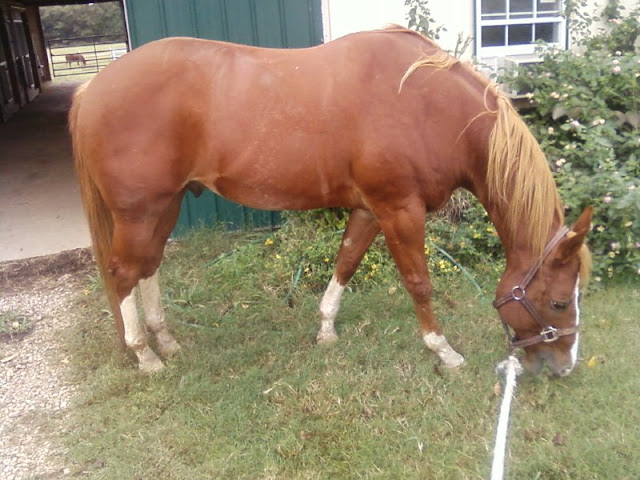I don't know what it is, but despite all the Spilkeration that has gone on in my life, I still have a tendency to want to turn the horses into minions. Not to beat myself up about this, but there it is. I'm working on it.
One form this hegemony takes is the desire to Make George Do Things. One thing I like to ask him to do is to move his shoulder away. I ask him to do this because he
hates it, and for some reason I think I should be able to randomly make him do things he doesn't want to, just because he's a horse and I'm a human. Whenever I suggest he move his shoulder away (unless, of course, there's a good reason for it, in which case he is impeccably courteous), he gives me his best "You are such a bitch" look.
Yesterday evening, we were out having a pleasant time together - George getting his tummy scratched, me dancing about to keep my be-sandaled feet from being trampled - when I decided we would practice doing a teeny bit of shoulder moving. Only this time I was determined to be reeeaally nice about it, and make it completely optional, and not, well, not be such a bitch about it.
So I stood by his shoulder and pointed, not at his shoulder, but in the direction toward which I was asking his shoulder to move, holding my arm in front of his chest. Pretty soon he did move in the desired manner, with the result that his butt came round to a good scratching position. That works.
Later, I tried again. Before granting me my whim, George first had to focus on some other agenda items. First we had to stare into the distance at some deer, and then we had to scratch his chest. And also he first had to make
me move away from
him. He achieved this by the not-so-subtle means of nudging me over with his head. Fair enough. And then finally he did move away in the desired manner, again bringing his quarters back to scratching position.
But only for a moment. He disengaged from scratching, carefully backed up to re-position me by his shoulder, said, "Allow me to demonstrate once more," and again moved his shoulder away from me. Then back to scratching.
So he schooled me in patience, reciprocity, and shoulder moving, without ever once telling me I was a bitch.
This morning, as I returned from yoga, Chloe was waiting for me and marched up to the fence while I was parking the car. Clearly she was a pony on a mission, and as I assumed it involved Improved Grazing Opportunities, I opened the two gates which face each other on either side of the drive and ushered George, Bridget, and Rose out from their current pasture over into the barn pasture. Chloe did not follow - the normal rules do not apply to her - so I shut the others in and let her stay out.
She nibbled a little clover but then walked purposefully over to me. It's been quite a while since she's let me climb on her back, but today I was getting the feeling that maybe it would ok. So I got into - well, it's not
mounting position cos that would be giving me too much credit - let's call it scrambling-aboard position. Chloe stood still while I plonked myself like a sack of meal over her back. Feeling that it might be nice if there were less flailing and more dignity involved in the next step of actually getting one leg over Chloe's back, I went in and fetched out the kitchen step stool to aid in the process. But when I put it next to Chloe and stood on it, she walked forward. Only a couple of steps though. She walked forward, stopped, and waited. Ok, no step stool.
I got back into scrambling-aboard position, and Chloe stood, planting her feet, giving that kind of solid, reliable feeling that seems to say, "That's ok, take all the time you need. I know you're a complete klutz; I'll just stand here til you're up." Once I was up, Chloe turned her head to inspect my leg, looking at it rather indulgently. Then she set off. She's very careful not to unseat me, and at first she stops every step or two, as she can feel my wobbliness. (Tall person on short pony makes for an unstable situation.) She walked over to the gate where the other horses were and stopped. I got off and asked her if she wanted to go in, but the other horses were crowding the gate, and she didn't want to.
For a little while, I pottered about doing other things. Chloe wandered down the drive a little, and when I went to see what she was up to, she seemed to invite me on board once more. So I scrambled on. Chloe turned to inspect my leg again and then carefully walked up to the gate. This time the other horses were out of the way, so when I got off and opened the gate for Chloe, she went right in.
I don't know what Chloe's plan was, or even if it was a plan. But it sure seemed like one.









